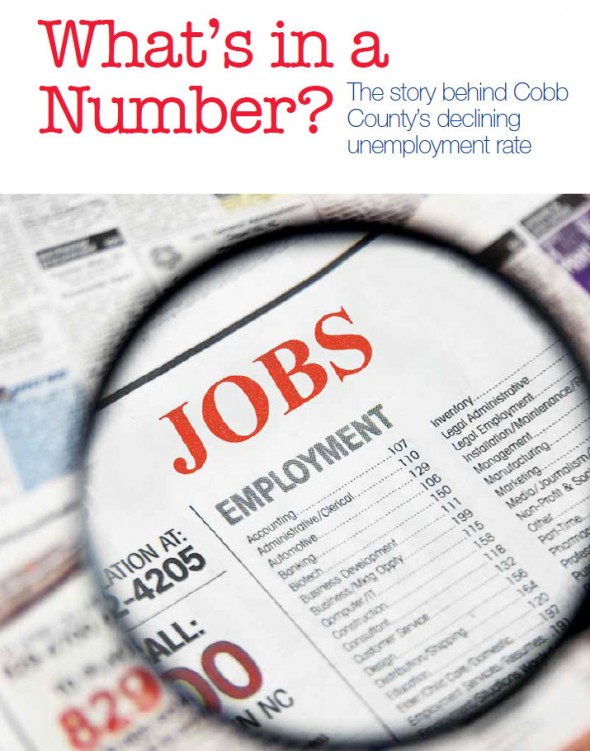
The results are in. The most recently published data on jobless numbers in Cobb County show the unemployment rate dropping to 6.9 percent in April. That’s three tenths of a point lower than the month before, compared to 7.8 at the start of 2013 and 8.0—constituting more than a full percentage drop—this time last year. The unemployment rates for metro Atlanta and Georgia also decreased, respectively, to 7.6 (again, down three tenths of a point from its March figure) and 8.2 (from 9.1 a year ago).* The national rate, currently at 7.5, has been tracing a similar, though slower, decline, falling a total of 0.4 percent since January. That’s a lot of stats to make sense of—and we haven’t even gotten to the (non-seasonally-adjusted) workforce estimates.
Most of us take for granted that a shrinking unemployment rate is good news. Fewer of us understand what’s behind these numbers, and what they could mean for our hometown economy. Cobb In Focus, in partnership with Marietta.com, turned to both local government leaders and local businesses to get a clearer picture of jobs in Cobb, and how the county plans to put these numbers to work.
Statistically Speaking
While the economic theories and calculations behind unemployment, or “joblessness,” are relatively complex (the U.S. Bureau of Labor Statistics measures no fewer than six different types of unemployment, for starters), the unemployment rate as we know it is based on a fairly simple principle: By estimating how many people are out of work in a particular area, we can better gauge how well that area’s economy is performing. The power of the unemployment rate to forecast our economic present and future waxes and wanes depending upon which expert you ask. The public interest in the unemployment rate as an economic predictor, however, is far more stable than our economy is ever likely to be. Just ask a politician, stockbroker, CEO—or the state labor commissioner.
Commissioner Mark Butler oversees the collection of unemployment statistics by the Georgia Department of Labor (GDOL), which are obtained in-house by tallying unemployment applications and surveys by county, combined and verified with data from the U.S. Department of Labor. He’s also responsible for communicating these findings to the public. When the state released its latest report in May, the official press release sent to local area outlets contained an audio clip of Commissioner Butler (interviewed by his director of communications) commenting on what he felt these numbers meant in the context of metro Atlanta. Clearly, he understands the sway the unemployment rate has come to hold over our perception of the local economy. But, while he stands behind the accuracy and usefulness of these statistics, he also acknowledges their limitations. In particular, he points to what is known as the workforce number, or the number that seeks to represent how many individuals in a particular area are either actively employed or actively seeking employment.
“[That’s] probably the one area that we hear most people talk about,” he says. “Anytime you see someone do an editorial or hear someone complain in an open forum, they’ll say, ‘Well, that’s not the real unemployment rate.’ A lot of times, what they’re referring to is the people who are, quote-unquote, ‘not counted.’” The workforce number doesn’t take into account those individuals who are unemployed, but who are also not looking for work—whether that’s because they are retired, on disability or because they gave up on finding a job. The latter is the one that raises an issue, as many believe that a true measure of unemployment should count those who have, for example, been without a job so long that they just plain stopped looking. Since overall unemployment is calculated as a percentage of that total workforce, shifts in the workforce number can have a major effect on the unemployment rate—an effect that doesn’t always give us the most accurate picture, Butler explains. “You can actually see the unemployment rate stay the same or decrease even though you have lost jobs.” How? “Let’s say you lost a small number of jobs … but you also had a lot of people drop off the workforce number.” If, as the argument holds, many of those now-uncounted workers gave up on looking for employment, you’re now calculating those newly laid-off individuals as a percentage of a reduced workforce. “That can actually make it look like you’re doing better than you actually are.”
The good news is that even with these kinds of limitations taken into account, most experts agree that if you look at all the unemployment data as a whole, it tends to add up to a pretty useful statistical picture. “When you see that workforce number increase and you see jobs increase, I think you have a fairly accurate unemployment rate,” Butler says. And in that case, he adds, “In Cobb, you guys are doing pretty good. It’s the lowest your rate has been since November 2008—2008 is what most experts deem the start of the recession. Back then, you were as low as 6.5 percent, so we’re starting to see Cobb County, slowly but surely, get back to pre-recession levels.”
More Jobs for Cobb
Complex statistics can help us to better understand our economy on a very broad scale in terms of entire counties, states and nations. But oftentimes the most convincing data comes in much smaller batches, and hits much closer to home—say, 60 more jobs at the Talenti Gelato manufacturing company in Marietta, an anticipated 120 local jobs to open through Fresenius Medical, a leading supplier of dialysis products and services, or more than 200 jobs newly added to Cobb’s growing business technology industry through Infosys. Call centers for Cobb-based global giant The Home Depot have recently added 700 jobs, while a similar center for Alorica, a customer management company with operations in Kennesaw, plans to hire more than 1,000 employees by the end of the year. News like this not only starts to put names, and maybe even faces, to disembodied statistics—according to Matt McCaslin, a certified staffing professional and office branch manager for Hire Dynamics in Cobb, it also constitutes tangible proof that Cobb County’s officially declining unemployment rate is right on target.
“This is not surprising at all,” he says, looking at the most recent statistics for Cobb as compared to a few months and a full year ago, “because we are seeing more job creation in the county and fewer layoffs.” As for what’s driving the numbers, McCaslin points to a mix of optimism and caution on the part of employers. Citing workforce surveys indicating that 26 percent of employers plan to take on more full-time employees in 2013, while 40 percent will be looking for part-timers and contractors, he says Cobb’s figures are on-trend. “We have seen direct-hire, full-time employment pick up in Cobb, but we have seen a more cautious ‘try before you buy’ approach to hiring, by starting employees out as contracted workers and then promoting them into full-time employment.”
Cobb also appears to be making the most of a recovering economic climate, choosing to wisely spread its roots now in preparation for larger, faster growth in the future. “Low interest rates have made it possible to expand operations, and companies are hiring in the anticipation of the growing economy,” says McCaslin. “Nobody wants to be the last person to the dance, and companies are hiring in order to capitalize on market share in their respective industries.” Not surprisingly, some industries and positions are expanding more than others. “According to Careerbuilder’s 2013 Job Forecast, the top two positions companies plan to hire for in 2013 are sales and information technology,” he says, predictions that are in line with recent job creation numbers in Cobb. McCaslin also notes that two of Cobb’s other leading industries, health care and customer services, also added significant jobs—mirroring larger trends.
These trends explain why many business set up shop in Cobb. “Infosys established itself in Cobb sometime in the early part of 2011. We then created a value proposition around our service offering and delivery model from the county and took it to the market,” explains Madhusudan Menon, Geo Head, North America of Infosys BPO Limited. “Based on the outcome, we are now hiring locally and adding to the employment count.” Menon notes that Infosys projects adding an increase between 50 and 70 percent to its current 300-person workforce in the metro area, with hiring focused on IT, customer service, insurance, health care, financial accounting and management.
A Great Place to Work
“More jobs equals better opportunity for all, whether you are a citizen, business or employee in Cobb,” says Brooks Mathis, vice president of economic development for the Cobb Chamber of Commerce. “Raising the bar helps each and every person within that equation.” According to both Mathis and Butler, Cobb has always set the bar relatively high when it comes to creating a positive economic climate. “Cobb just has a very good business atmosphere,” Butler says, “and, frankly, it always has—which is one of the reasons why you’re seeing the job growth the way you are. If you even take a look at the average wages overall, the average weekly wage is higher in Cobb County than it is for the rest of the state of Georgia. So, not only are your businesses creating jobs, but they tend to be a little bit higher paying jobs.” That’s great news for employees, indeed.
More good news, for employees and employers alike: Cobb boasts the lowest crime and tax rates in metro Atlanta, a viable public transportation system and dedicated employment and economic development programs like CobbWorks, the county’s employment services leader, and Cobb’s Competitive EDGE, a partnership of local businesses and government leaders that aims to significantly boost the number and quality of jobs in Cobb by 2018. In other words, it’s a great place to work—and local businesses know it. “These companies are adding jobs because the talent is in Cobb, and the proximity to metro Atlanta and low cost of doing business exists here,” Mathis says.
In addition to those thousands of jobs added and slated to be added in 2013, Butler estimates that Cobb has seen almost 2,800 more people enter or re-enter the workforce since 2012, while only a tiny fraction—213 workers—dropped off the workforce number in April. That likely means that Cobb is not only adding jobs, but also doing a better job of filling them.
Quality Meets Quantity
Creating more jobs, or even better jobs, isn’t enough. The discrepancy between the demands of available jobs and applicants’ abilities to meet them is referred to as the “skills gap.” While the actual impact of the skills gap on the unemployment rate is up for debate, there is no doubt that a lack of qualified workers is a barrier to economic success. Jobs that are created only to go unfilled—or filled with unsuitable candidates—can not only cost companies more money (in hiring, human resources and training costs, for example), they send companies the message that the local workforce isn’t worth their investment. Technical skills are one part of the equation, says Butler, but soft skills, or “common sense” skills as he calls them—things like punctuality, professional presentation and a sense of workplace decorum—are of increasing concern to employers. “Businesses are having a hard time finding individuals with the right technical skills for the jobs that are available, but we’re also hearing businesses say that a lot of individuals don’t have the soft skills needed, even if they do have the technical skills,” he says. Cobb is fortunate to have one of the highest-rated educational systems in the metro area, as well as four of Chattahoochee Technical College’s eight campuses (including the main campus on South Cobb Drive). “Chattahoochee Tech does a great job supplying [Cobb’s] workforce with good qualified graduates,” says Butler. Infosys’ Menon notes that the company works closely with area schools like Kennesaw State and Chattahoochee Tech to hire and train local talent.
Until recently, however, no comparable programs were directly addressing the skills gap as far as those “common sense” skills were concerned. In response to this need, the Georgia Department of Labor created Georgia Business Ethics Student Training (BEST), a program designed to teach career-oriented soft skills and life skills to high school seniors. The program was piloted last year in more than 20 schools across Georgia, and has grown to more than 150 schools. Support for the program from students, parents, educators and employers has been encouraging. Says Butler, “We think it’s going to have a profound effect on the workforce because this is an area that is much needed, and we’re looking to expand the program to middle schools and also to our current workforce programs and our career centers.” Another new initiative geared toward unemployed and underemployed adults, Special Workforce Assistance Team (SWAT), brings job seekers together with Georgia Department of Labor representatives to polish interview skills (including soft skills), receive resume assistance and access job-matching resources.
On the county level, Mathis says, “Cobb is addressing future employment issues, workforce development and talent opportunities through its new community and economic development strategy, Cobb’s Competitive EDGE.” One of EDGE’s seven “action teams,” composed of representatives from Cobb’s educational system, CobbWorks and local staffing firms, has been specifically tasked with the title “Developing, Recruiting & Retaining Talent.”
According to Butler, this targeted, local- and individual-centered approach to communities’ employment needs is representative of the shift Georgia’s government leaders are making away from statistical measurements like the unemployment rate. It’s not that these numbers aren’t useful or important, he says—declining to comment on what he would consider a target unemployment rate for Cobb—it’s just that they don’t add up to the best strategy for tackling unemployment at its uniquely specific sources. “I really don’t want to put it into a number. The reason why I don’t is we’re changing the mindset of how we handle our clients at the Department of Labor. We don’t want to think about it as a statistic.”
“Taking an individual approach,” he adds, “it takes longer, it’s definitely much harder to do, but it’s the only way you’re really going to have a real effect.”
For those still keeping count, the newest unemployment numbers for Cobb County and the State of Georgia will be released on June 21.


















